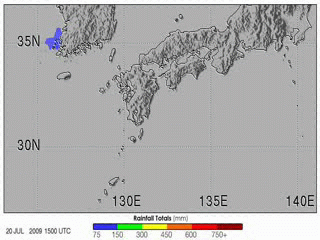Датотека:Heavy Rains in Southern Japan.gif
Appearance
Heavy_Rains_in_Southern_Japan.gif (320 × 240 piksela, veličina datoteke: 8,35 MB, MIME tip: image/gif, petlja, 268 kadrova, 8,0 s)
Istorija datoteke
Kliknite na datum/vreme da biste videli tadašnju verziju datoteke.
| Datum/vreme | Minijatura | Dimenzije | Korisnik | Komentar | |
|---|---|---|---|---|---|
| trenutna | 23:56, 31. jul 2009. |  | 320 × 240 (8,35 MB) | Originalwana | {{Information |Description={{en|1=The 2009 summer monsoon brought torrential rains to south western Japan in July. This animatin shows rainfall estimates for southern Japan and the surrounding region from July 20–27. The most prominent feature is a larg |
Upotreba datoteke
Nema stranica koje koriste ovu datoteku.
Globalna upotreba datoteke
Drugi vikiji koji koriste ovu datoteku:
- Upotreba na cs.wikipedia.org
- Upotreba na en.wikipedia.org
- Upotreba na fi.wikipedia.org
- Upotreba na id.wikipedia.org
- Upotreba na ja.wikipedia.org
- Upotreba na ms.wikipedia.org
- Upotreba na si.wikipedia.org
- Upotreba na te.wikipedia.org
- Upotreba na uk.wikipedia.org
- Upotreba na vi.wikipedia.org
- Upotreba na www.wikidata.org
- Upotreba na zh.wikipedia.org



